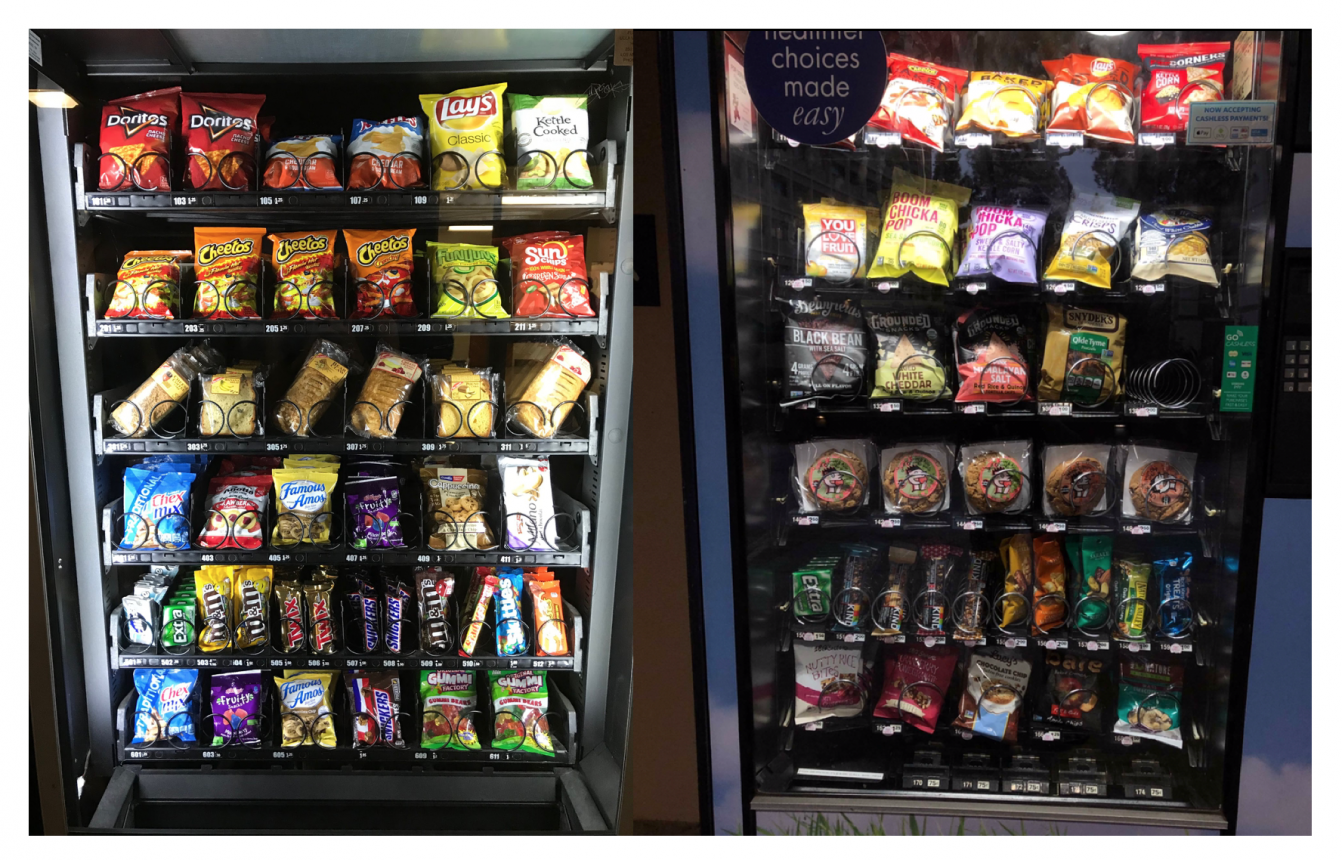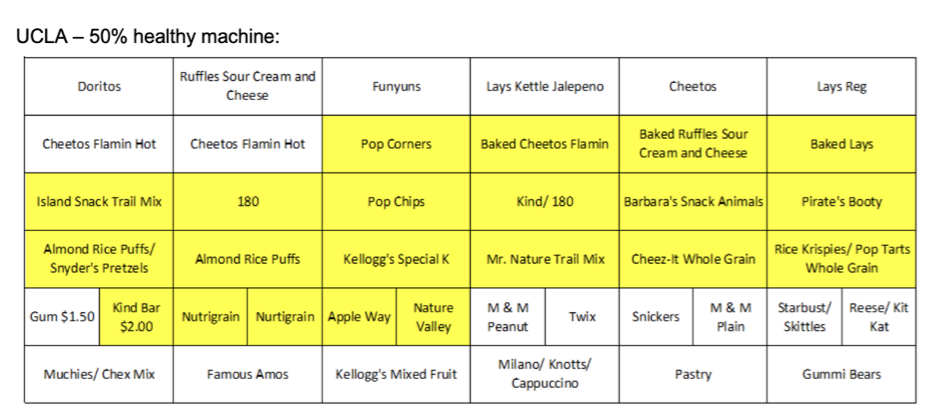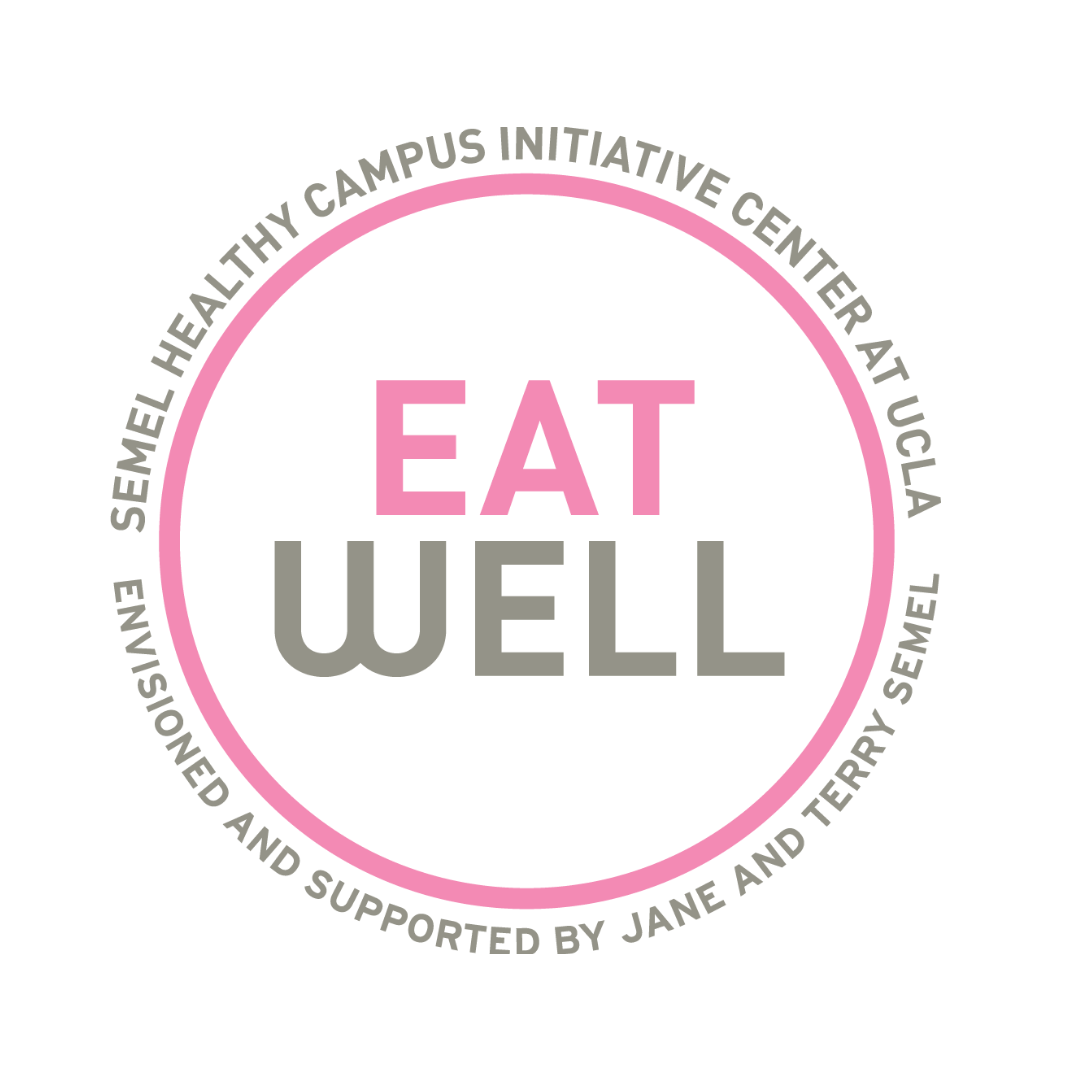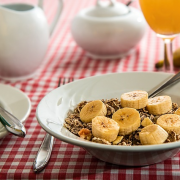The Road to Healthy Vending at UCLA
Have you noticed a transition in the snacks and beverages offered in vending machines on campus? What about those “healthier choices made easy” stickers on the outside of the machine and “EatWell” stickers on individual snacks? Did you know that healthier snacks have been strategically placed closer to eye-level? Each of these changes has been deliberately implemented over the past few years by the UC Healthy Vending Working Group (UC HVWG).
Some background on the UC HVWG: The Global Food Initiative (GFI), launched in 2014, utilizes the University of California’s power of research and extension in an effort to create and execute solutions for food security, health and sustainability. The UC HVWG was established as a GFI Project to ensure that all UC campuses provide access to nutritious snacks and beverages. To achieve this objective, the UC HVWG created a set of guidelines that outline the minimum requirements for healthy vending machines. One guideline, for example, dictates that all healthy food items must “have a fruit, vegetable, low-fat dairy, protein (including nuts and seeds), or whole grain as its first ingredient.”

A comparison of a traditional vending machine and a healthier vending machine at UCLA. Located at the Mathematical Sciences Building and the mailroom on the Hill, respectively.
According to these guidelines, all healthy beverages such as water, juice, milk, non-dairy milk, protein drinks, and tea/coffee must contain no added caloric sweeteners. “Low-calorie” beverages are permitted to contain added sugar if they contain fewer than 40 calories per 12 fluid ounces. Healthy snacks must contain no more than 250 calories, no trans fat, no more than 10 grams of fat, no more than 3 grams of saturated fat, no more than 360 milligrams of sodium, and no more than 20 grams of total sugar.
There are a few exceptions to these rules, including nuts, legumes, eggs, cheese, fruits/vegetables, and combinations of these items (e.g., a fruit and nut mix). Notice that all of these exceptions are whole foods, meaning foods that have undergone minimal processing and look as close as possible to the way they look when growing in nature. In general, whole foods are exempt from all requirements except the calorie and sodium requirements, as long as they don’t contain added sweeteners or fat!
Research reveals that “the adult population in the United States as a whole is deficient in certain micronutrients as a result of the availability and overconsumption of high-calorie, low-nutrient processed foods.” (Astrup and Bugle, 2019) In general, highly processed foods contain empty calories and have a much poorer nutrient profile than their unprocessed counterparts. The UC HVWG therefore targets these nutrient deficiencies and the consumption of empty calories by encouraging the consumption of whole foods instead.
98% Healthy Vending on Campus
At UCLA, the Semel HCI Center ensures that 50% of snacks in healthier vending machines follow UC Healthy Vending Working Group guidelines. But many machines go above and beyond! UCLA Dining Services currently operates a total of 105 snack vending machines, 100 of which follow the 50% healthy rule, and 14 of which are filled 100% with healthy snacks.
The UCLA campus is also home to 215 beverage vending machines, of which 107 beverage machines are “zero sugar”. The remaining 108 are “reduced sugar”. Zero sugar machines are located at Housing on the Hill, the Ronald Reagan Medical Center, and the Santa Monica Medical Center.
As Charles Wilcots, Associate Director of UCLA Dining Services reports, “We anticipate to increase more vending selections to offer healthier options in the near future as we get more available products. Our overall goal is for all vending machines in our inventory to comply with the GFI criteria.” With a total of 320 vending machines, and only 5 snack machines left to make the switch to the healthy vending guidelines, UCLA Dining Services is already 98% compliant with UC HVWG criteria!
Subtly Influencing Choice
There is inevitably much more to encouraging healthy choices than simply providing healthy options. Within the 50% healthy vending machines, the challenge then becomes ensuring that consumers choose from the healthier 50%. The UC HVWG employs a few key psychological tactics: placing healthy products at eye level, advertising healthy beverages on beautiful vending machine wraps featuring a background of green grass and blue skies, and decreasing the price of healthier products, while increasing the price of unhealthy products. In a study by French and colleagues (2010), the proportion of healthy to unhealthy items in vending machines was increased to 50% healthy items and 50% unhealthy items. When prices of healthy items were lowered by an average of 31%, sales of healthy items increased by up to 42%. Because who wouldn’t rather choose the cheaper (and healthier!) snack?

Six sample plans for UCLA vending machines. Snacks in yellow are designated “healthy snacks”, and stocked at eye-level.
It’s fair to ask whether any of this is actually profitable. Healthier snacks at grocery stores are generally more expensive than highly-processed, large-scale manufactured snacks. Wouldn’t it follow that reducing the prices of expensive healthy snacks in vending machines decreases profit? A study by Viana and colleagues (2017) at UCLA found this assumption to be false.
In their research, two types of machines were compared: “intervention machines”, with 50% healthy options, and “comparison machines”, with a usual assortment of snacks (see pictures above). Viana and colleagues found that 21.3% of snacks purchased from intervention machines were healthy, whereas only 1.3% of snacks purchased from comparison machines were healthy. Since cost per item was increased from approximately $0.99 to $1.08 between 2012 and 2013, revenue was able to remain consistent. These findings suggest that “health-promoting interventions can influence vending machine consumers without compromising revenue or profit.” (Viana et al., 2017)
By strategically encouraging healthier snacking, the UC HVWG and the UCLA Semel HCI Center aims to “make the healthy choice the easy choice.” Unfortunately, supermarkets and food manufacturers may not always share this goal, so keep a careful eye out for foods marketed as healthy that are potentially not so great for you.
References
Viana, J; Leonard, S. A; Kitay, B; Ansel, D; Angelis, P; Slusser, W. (2017) “Healthier vending machines in a university setting: Effective and financially sustainable.” Appetite Vol. 121: 263-267. DOI: 10.1016/j.appet.2017.11.094
French, S.A; Hannan, P.J; Harnack, L.J; Mitchell, N.R; Toomey, T.L; Gerlach, A. (2010) “Pricing and availability intervention in vending machines at four bus garages.” Journal of Occupational and Environmental Medicine Vol. 52: S29-S33.
Astrup, A; Bugel, S. (2019) “Overfed but undernourished: recognizing nutritional inadequacies/deficiencies in patients with overweight or obesity” International Journal of Obesity Vol. 43, Iss. 2: 219-232 DOI: 10.1038/s41366-018-0143-9
Patience Olsen is an undergraduate student at UCLA majoring in Civil Engineering. In addition to blogging for the EatWell Pod, she volunteers at the Mildred E. Mathias Botanical Garden on campus, and is a member of the ASCE Environmental Design project.










